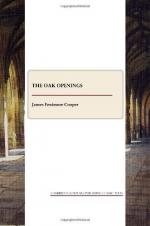On Prairie Round there was even a higher stamp of seeming civilization—seeming, since it was nature, after all, that had mainly drawn the picture. In the first place, the spot had been burnt so recently, as to leave the entire expanse covered with young grasses and flowers, the same as if it were a well-kept park. This feature, at that advanced period of the summer, was in some degree accidental, the burning of the prairies depending more or less on contingencies of that sort. We have now less to do with the cause, than with its consequences. These were most agreeable to the eye, as well as comfortable to the foot, the grass nowhere being of a height to impede movement, or, what was of still more importance to le Bourdon’s present pursuit, to overshadow the flowers. Aware of this fact, he had led his companions all that distance, to reach this scene of remarkable rural beauty, in order that he might make a grand display of his art, in presence of the assembled chiefs of that region. The bee-hunter had pride in his craft, the same as any other skilful workman who had gained a reputation by his cunning, and he now trod the prairie with a firmer step, and a more kindling eye, than was his wont in the commoner haunts of his calling. Men were there whom it might be an honor to surprise, and pretty Margery was there also, she who had so long desired to see this very exhibition.
But to revert once more to the prairie, ere we commence the narrative of what occurred on it. This well-known area is of no great extent, possessing a surface about equal to that of one of the larger parks of Europe. Its name was derived from its form, which, without being absolutely regular, had so near an approach to a circle as to justify the use of the appellation. The face of this charming field was neither waving, or what is called “rolling,” nor a dead flat, as often occurs with river bottoms. It had just enough of undulation to prevent too much moisture, and to impart an agreeable variety to its plain. As a whole, it was clear of the forest; quite as much so as if the axe had done its work there a thousand years before, though wood was not wanting. On the contrary, enough of the last was to be seen, in addition to that which formed the frame of this charming landscape, to relieve the view from all appearance of monotony, and to break it up into copses, thickets, trees in small clusters, and in most of the varieties that embellish native scenery. One who had been unexpectedly transferred to the spot, might well have imagined that he was looking on the site of some old and long-established settlement, from which every appliance of human industry had been suddenly and simultaneously abstracted. Of houses, out-buildings, fences, stacks, and husbandry, there were no signs; unless the even and verdant sward, that was spread like a vast carpet, sprinkled with flowers, could have been deemed a sign of the last. There were the glades, vistas, irregular lawns, and woods, shaped with the pleasing outlines of the free hand of nature, as if consummate art had been endeavoring to imitate our great mistress in one of her most graceful moods.




